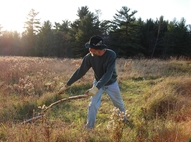A History of Harvesting Grains, from the Scythe to Gigantic Modern CombinesWhile it's amazing what a $500,000 combine can do, how does a small acreage farmer homesteader grow and harvest their own grain? Even small walk-behind combines cost a fortune. From 4:40 to 14:14, the above documentary shows how grains used to be harvested by hand, with a scythe and a flail. There is some good historical footage in this video. While the modern reenactment was done when the grain was at peak ripeness, the narrator explains at 6:55 that grains were traditionally harvested with a scythe before peak ripeness, so fewer grains would get knocked loose while harvesting. Then the grain was tied into sheaves and stacked in the field, in shocks, to finish ripening. Modern combines harvest wheat at complete ripeness.
0 Comments
From my limited experience with harvesting grains, I would say that oats have got to be one of the easiest grains to mow with a scythe, but one of the hardest to mow neatly. It practically jumps out of the way of the scythe blade, but the grain heads fall to the right, or every which way, unless you use a grain cradle. "Where can I get a grain cradle?", you ask. If I could get them, believe me, I would carry them. Unfortunately, I don't know of anybody that still manufactures a grain-cradle. It's on my list of products to develop for 1SR, but until then you will have to make your own. Or.... you could try this simple technique. In the video below, these people are implementing a brilliant idea that I have not seen, or heard of before. An assistant to the scyther, holds a light pole against the standing grain, for the scyther's next stroke, which keeps it from falling over, and apparently has the effect of guiding the stalks to move over to the left, just like it would with a grain cradle! I can't wait to try this myself! If any of you get to it before I do, let me know how it works out. I just found a great video on YouTube of a traditional wheat harvest demonstration in Germany. It shows the sophisticated German bow cradle in use, and how the scythe is swung into the standing grain. The cradle presses the cut grain stems up against the standing stems, to compresses the fallen grain stems into alignment, to make it easier to gather them into sheaves. See the link below. For more info, also check out my grain Harvesting workshop page. Harvesting Grains
A scythe can be used to harvest building materials. Reed Canary grass can be harvested in early winter for making thatched roofs and cob building. If harvested in early winter after a couple of light snows, and freezes and thaws, the leaves tend to fall off, leaving mostly stalks, which is better for thatching. Reed Canary grass can also be harvested in late Fall, in prime condition, and stored for the next season of cob building. Run it through a chipper and mix with the clay for cob building. What would be more fitting roofing material for a cob building, than a thatched roof. Here is a nice little video on the traditional method of harvesting water reed with a scythe, for thatching roofs. Water reed makes the most durable thatched roof, but the long straw from heritage grains can also be used for thatching. My Sepp Holzer rye would make a nice straw for that, as would my Black Winter Emmer wheat, I would guess. They are both at least 5ft tall, with great stems. I would love to experiment with that, if only I had more time, and energy, and money! Who wouldn't like to live in a place like this: Is there any interest in thatching in the USA? Yes, there is. See these links:
http://journal.goingslowly.com/2012/12/thinking-about-thatch http://journal.goingslowly.com/2012/12/reed-collecting-tools-sickles-scythes http://journal.goingslowly.com/2013/01/reed-collecting-thatching-with-deanne-bednar The winter grains are thigh high already. Time to finally figure out a homemade grain cradle, of some sort. Here are a couple of ideas, from wildseed01 on YouTube. Thanks Wildseed01 for sharing this good info! Below is a simple bow cradle (boyle) with a pricker. See 0:54 for still picture. This one can be completely homemade with some green willow, a thin angle iron, and some good twine. This is Crabapple farm in Chesterfield, MA. Tevis is harvesting the wheat using an European scythe and the sickle follows.
Another great harvest video. YouTube sure is a goldmine of info. This one was posted by tempo2002 . It was shot in Super-8 film by Folker B. Jung, in 1983. I think it takes place in southern Germany. Excellent close-up views of the F.A.O.-style grain cradle's construction, and in action! There is a drawing of the F.A.O. cradle on page 77 of The Scythe Book, though the cradles in this video look more artfully constructed. |
Botan AndersonArchives
March 2023
Categories
All
|




 RSS Feed
RSS Feed